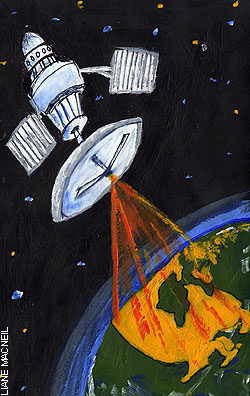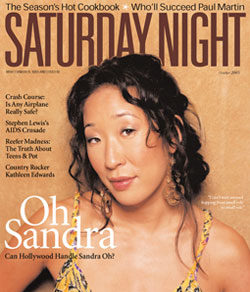I’m giggling to the Howard Stern Show on 92.9 JACK FM during my Tuesday morning drive to the School of Journalism at Ryerson University in downtown Toronto. It’s one of Stern’s last programs on the Buffalo station, just before he makes his much-publicized jump to Sirius Satellite Radio. That’s when Canadians living near the U.S. border will no longer be able pick up his show for free. Today’s topic is: Guess the weight of High Pitch Eric’s excrement.
High Pitch Eric is a large, balding man – think Mike Tyson without the muscle tone – whose voice hits frequencies only a dog can discern. While High Pitch’s vocal cords are normally the focus, today it’s his bowel movement. When I first tune in, I think they’re guessing the weight of an elephant’s dung droppings. But no, it’s a real person’s. A large person’s.
Stern’s crew has set up its equipment – and a makeshift toilet in the middle of High Pitch’s apartment – to document the contest on-air. Back in the studio, Stern and co-host Robin Quivers wait eagerly for High Pitch’s business to cease and the weigh-in to begin. They’ve placed their wagers. Stern confidently holds the under bet – $500 on 3.5 pounds or less – because he interviewed a zoo employee and was told that the amount of feces large animals produce is surprisingly low.
At one point, amidst Stern and the gang haggling over their bets and the vivid descriptions of High Pitch’s activity, they receive a warning. Tom Chiusano, general manager for WXRK, Infinity Broadcasting’s rock station in New York, tells them they’re violating Federal Communications Commission (FCC) obscenity guidelines. Again. As usual, they’re warned if they don’t tone it down they’ll be censored.
That’s when Stern’s lament begins. He’s tired of the censorship. He thinks it hurts his credibility. Beginning January 1, 2006, he’ll unlock the FCC’s shackles and enter the promised land of satellite radio. Of course, it helps that Sirius is paying him $500 million over five years to break those chains.
Satellite radio is being touted as the new, free-form environment south of the border, but increasingly it looks as if this will not be the case in Canada. “It won’t be the wild, wild west that it purports to be in the States,” says Jeff Marek, AM 640’s director of sports programming. “Shows like Stern’s won’t be made available in Canada because it doesn’t meet CRTC regulations.”
CRTC stands for Canadian Radio Telecommunications Commission, a regulatory body that, since 1968, has been responsible for determining what Canadians listen to and watch. It decided in November 2001 that Stern was too offensive for Canadian sensibilities. Despite good ratings, the show was pulled from the Corus Radio?owned CILQ FM – better known as Q107 Toronto’s Classic Rock – because of complaints from the public that it was offensive.
But in this new era of 500 TV channels, the Internet and satellite radio, some people wonder if the CRTC hasn’t become a meddlesome regulatory body that has outlived its usefulness. Two large, intensely competitive American corporations, Sirius and XM Satellite Radio – as well as a Canadian consortium of CHUM Ltd. and Astral Media – have been trying to get past CRTC objections and pry open the Canadian market, but it’s been a slow process.
All three companies were approved for a license June 16, 2005, and then the decision was appealed. There were misgivings about the stations not being compelled to provide enough Canadian content, particularly French-language programming. To avoid further delays, the trio of entrants voluntarily modified their CRTC license applications to include eight Canadian channels – four English and four French – with three of the four French-language channels offering music.
The CRTC allowed the public to voice its comments regarding the amended licenses until November 4, 2005. There is speculation that satellite radio stations will go to air in December 2005, but CRTC officer Maria DaSilva says, “That’s what the news reporters are saying, but don’t forget we have this process. It might be that by December we have our decision, but it might be that we don’t.” XM technical producer Aron Papernick, for one, believes they will, but says, “Companies may miss their original December 1 deadline because they were sidetracked in September and October by backbench, no-name Liberal policy wonks.”
The issue of Canadian content has been, and continues to be, at the forefront of the satellite debate in this country. As it stands XM, Sirius and CHUM-Astral must provide 20 per cent Canadian content, while traditional, or terrestrial, radio must provide 35 per cent – a 43 per cent drop in CanCon commitments.
This differential worries Jim Thompson, media representative for the Friends of Canadian Broadcasting lobby group. He’s concerned satellite radio might dilute the mount of Canadian content on both satellite and terrestrial radio. “Commercial radio stations have already called out for relief from the obligation they currently have to play Canadian artists,” he says, “on the grounds that satellite radio has a much lighter obligation when it comes to playing Canadian music. That will be a very powerful argument with commercial radio operations when they come before the CRTC to have their licenses renewed.”
There won’t be any arguments about lowering Canadian content, DaSilva vows, when it comes time for stations to renew their licenses with the CRTC. “Don’t make the comparison to the other regulations,” she says. “It’s two types of service. It’s the same thing for television – different regulations for different services. That’s why they’re not called commercial radio stations. They’re subscription radio stations.”
Concern for the amount of American influence satellite radio will have on Canadian audiences is one thing. Another is convincing consumers to spend money on something they currently get for free. Satellite receivers range in price from $130 to $300, and the monthly subscription rate is $12.99. For that kind of investment, Marek says, radio personnel have to be reminded of the adage: Content is king.
Marek likens satellite radio’s chances of success to the introduction of bottled water. Fifteen years ago, he argues, people were happy to use the water fountain. Now they’ll gladly pay two dollars a bottle, because it is perceived as a premium product. The onus, in other words, is on satellite radio executives to convince listeners they aren’t getting premium content on terrestrial radio.
And they may have a case. Satellite radio now boasts of carrying premium content like Martha Stewart, New York Times Radio, National Public Radio and Stern. “It’s up to the Siriuses and the XMs to present different voices, sounds, opinions, attitudes and ideas,” Marek says, “or they’ll just try to out-Nickleback each other.”
Even the vigilant Thompson is not convinced it will be successful. So far, XM and Sirius haven’t been able to attract enough subscribers in the U.S., and he suspects they may have to merge to turn a profit. “XM radio has about 5 million subscribers and Sirius has somewhere in the 3 million range,” he says. “My understanding is that either needs about 7.5 million subscribers to make money.”
While the CRTC seems intent on impeding the freewheeling Sterns of the world, what might happen on satellite radio in Canada – at least initially – is a lot of simulcasting. Sirius radio is already dabbling in it, striking a deal with the television show The Score to simulcast its sports updates. “Let’s not forget,” says Marek, “satellite radio has to get content from somewhere.”
This kind of synergy is at best a timid use of satellite radio, but ultimately it could offer terrestrial radio a chance to rethink itself – something it hasn’t done in decades. At first, radio listeners didn’t have much choice and listened to whatever was available on the AM dial. When FM came along in the 1960s, it took a while for senior radio personnel to figure out how to program it. Now we’re at the beginning of this process again. “It’s another evolution in the technology,” says Marek, “which is going to engender a revolution in programming.”
The revolution will remain unprovoked for a while, according to Papernick, who says this transitional period has created a “curious vibe” in the industry. “They still see it as radio,” he says. “They don’t see it as new format.”
About the author
Julie Meehan was the Online Editor for the Summer 2006 issue of the Ryerson Review of Journalism.


